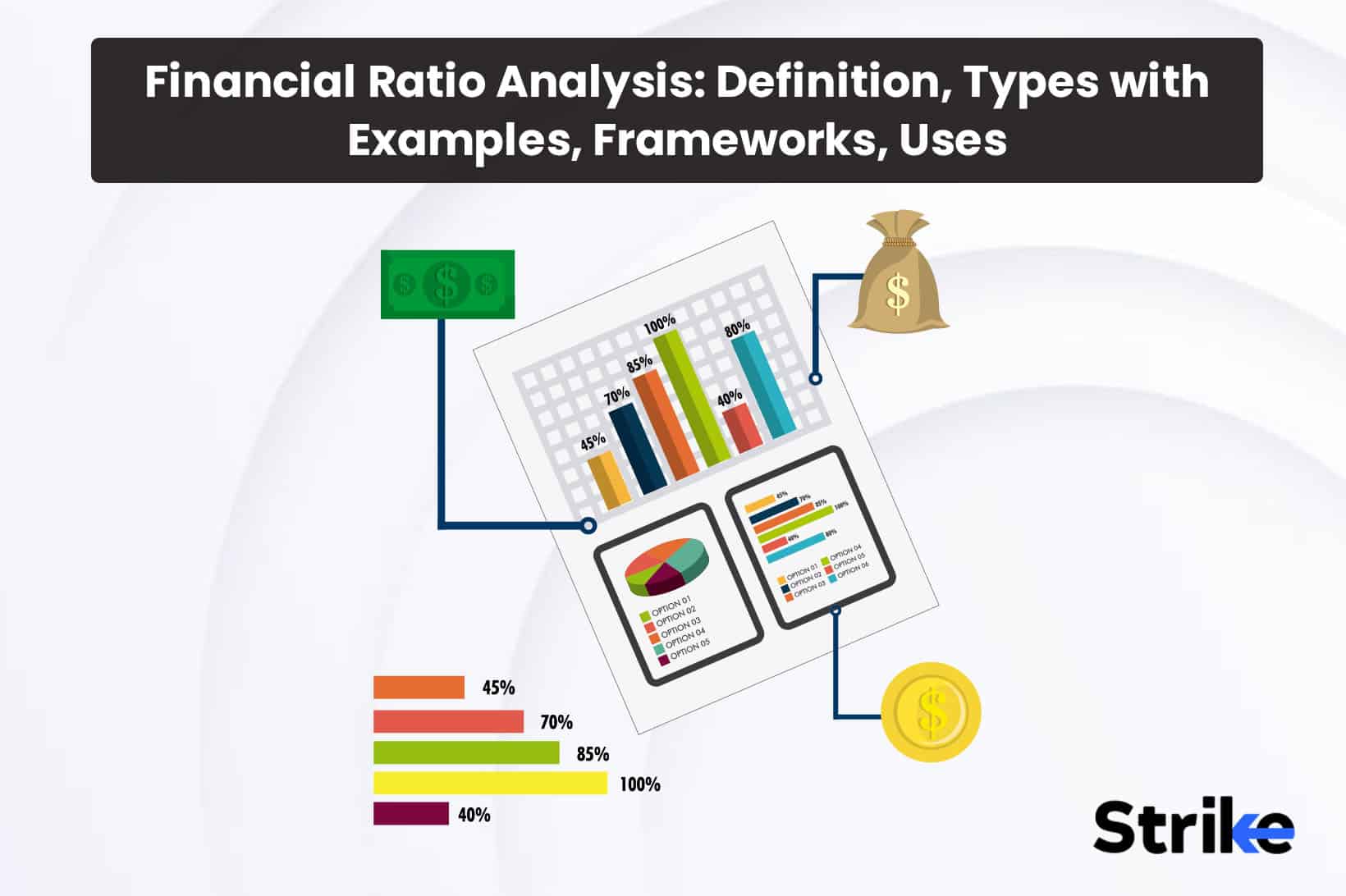
Financial ratio analysis is a tool used by investors, creditors, and company managers to evaluate various aspects of a company’s financial health and performance. Financial ratios are calculated by comparing key financial metrics derived from the income statement, balance sheet, and cash flow statement. Common types of ratios analyzed include liquidity, solvency, profitability, and efficiency ratios.
By tracking ratios over time and benchmarking them against competitors and industry averages, valuable insights can be gained into a company’s financial position, operating results, risk levels, and how effectively management is running the business. Proper ratio analysis provides a quantitative assessment of a company’s financial condition, identifying strengths, weaknesses, and potential risks that can inform investment and financing decisions. Understanding trends in key financial ratios is essential for a thorough fundamental analysis of public companies.
What are financial ratios?
Financial ratios are mathematical calculations used to analyze a company’s financial statements. Financial ratios provide insights into performance by comparing values over time and against industry benchmarks. The main categories of financial ratios are liquidity ratios, which measure short-term financial health; solvency ratios, which evaluate long-term financial leverage and debt repayment capacity; efficiency ratios, which gauge how well assets are managed to generate revenues; profitability ratios, which assess the ability to generate profits from operations and valuation ratios which determine if a stock is over or undervalued compared to financial metrics.
Analyzing trends in these ratios helps identify strengths, weaknesses, and competitive positioning. They provide quantitative data to evaluate financial condition, operating performance, profit generation, debt levels, and valuation. Comparing ratios over time and to industry standards facilitates informed analysis and investment decisions regarding a company’s financial standing and operational effectiveness.
How does financial ratio analysis work?
Financial ratio analysis works by calculating and interpreting various ratios using data from a company’s financial statements in order to analyze its financial condition, operational efficiency, and profitability. Analysts calculate key ratios such as liquidity, solvency, Turnover, profitability, and valuation ratios using line items from the balance sheet, income statement, and cash flow statement. Liquidity ratios like current and quick ratios measure short-term financial health and the ability to pay debts as they come due.
Solvency ratios like debt-to-equity evaluate long-term debt obligations and financial leverage. Efficiency ratios like inventory turnover gauge how well assets are managed to generate revenues. Profitability ratios like return on equity assess the company’s ability to generate profits from its operations. Valuation ratios like price-to-earnings help determine if a stock is potentially over or undervalued.
What are the types of financial ratios?
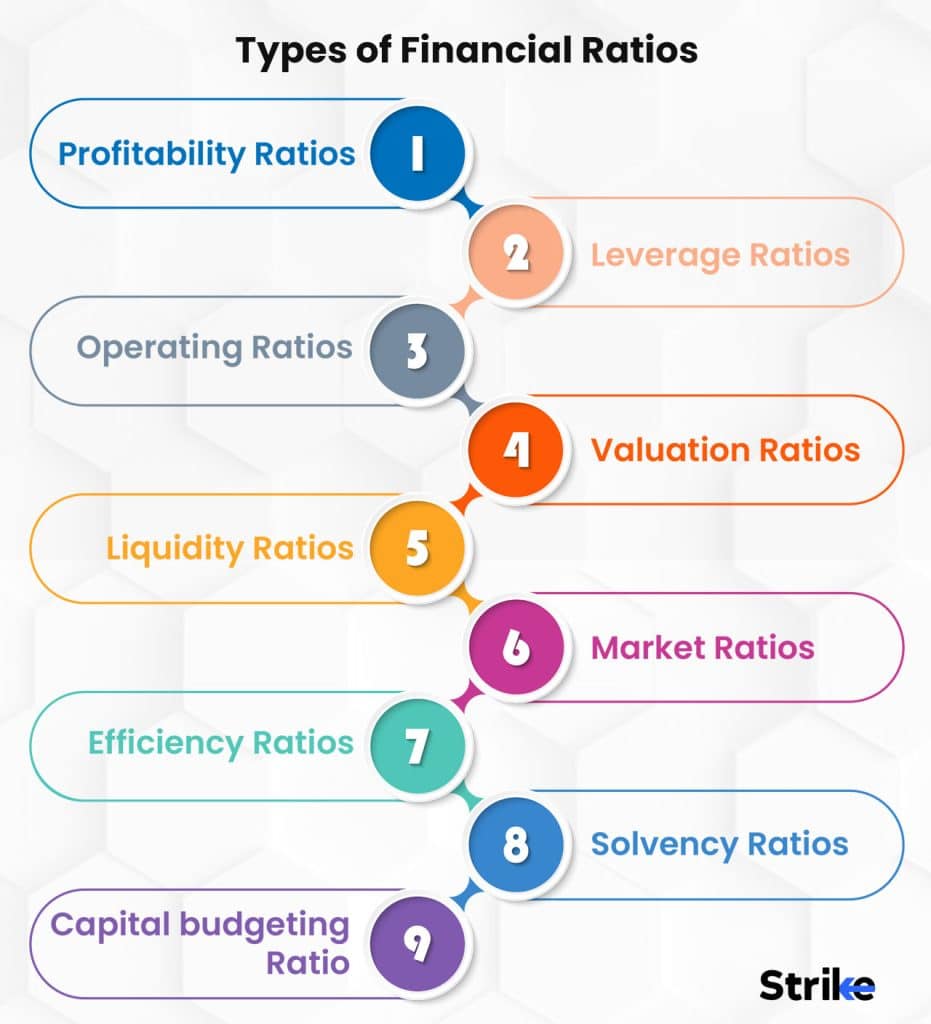
The key categories of financial ratios are liquidity ratios, solvency ratios, efficiency ratios, profitability ratios, and valuation ratios. Liquidity ratios measure short-term financial viability, solvency ratios evaluate debt levels and repayment ability, efficiency ratios gauge asset management, profitability ratios assess profit generation, and valuation ratios determine if a stock is over or undervalued. Analyzing trends across these ratio types provides insights into a company’s financial health, operating performance, and valuation for quantitative financial analysis.
1. Profitability Ratios
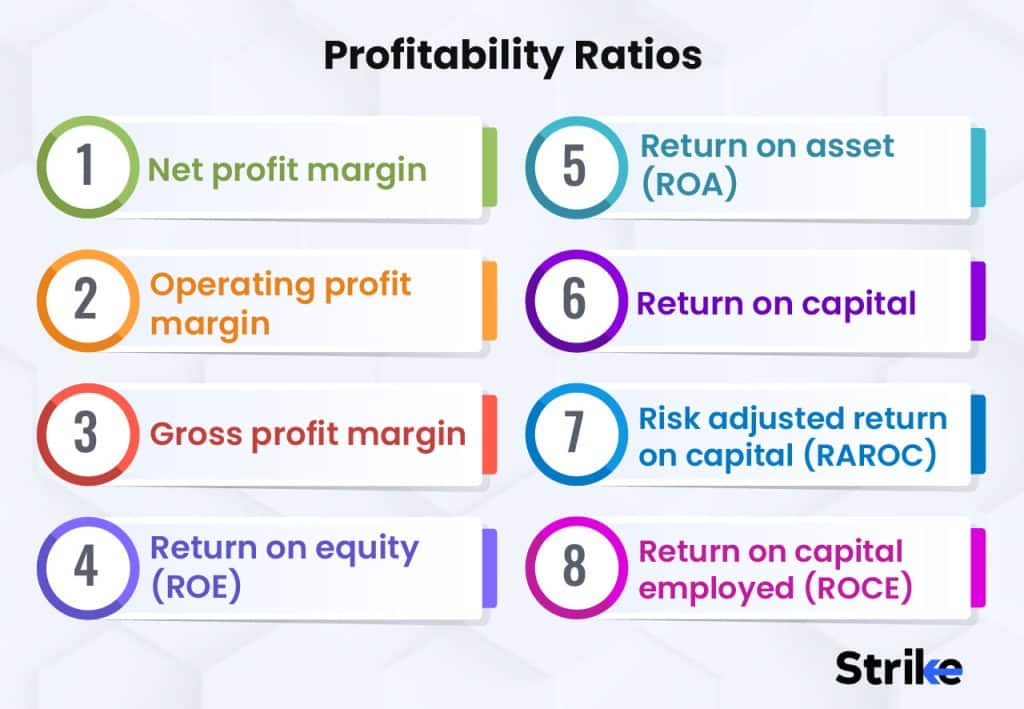
Profitability ratios are important metrics for evaluating a company’s earnings performance and ability to generate profits from its operations. Analyzing trends in these ratios helps determine the efficiency and sustainability of a company’s profits, which is crucial for stock valuation and investment decisions. Higher and improving profitability ratios generally indicate that the company has stronger earning potential and capacity to provide attractive returns for shareholders.
Net profit margin
The net profit margin is a profitability ratio that measures how much net income a company generates per dollar of revenue.
Net Profit Margin = (Net Income / Revenue) x 100
For example, suppose a company has Rs.10 million in revenue and Rs.2 million in net income; its net profit margin is = (Rs.2 million / Rs.10 million) x 100 = 20%.
So, the net profit margin shows that the company converted 20% of its revenue into net profits. This Ratio helps assess a company’s profitability and how efficiently it operates. The higher the net profit margin, the more financially stable the company.
Operating profit margin
The operating profit margin measures a company’s operating income as a percentage of its total revenue. It shows how much operating profit a company makes for each dollar of revenue.
Operating Profit Margin = Operating Income / Revenue
For example, suppose a company has Rs.20 million in revenue and Rs.4 million in operating income; its operating profit margin = Rs.4 million / Rs.20 million = 0.20 = 20%
So, for every Rs.1 of revenue, this company has Rs.0.20 of operating income. The higher the Ratio, the more efficiently a company is using its resources to generate operating profits. This Ratio helps evaluate a company’s operational efficiency and profitability from core operations.
Gross profit margin
The gross profit margin ratio shows the percentage of revenue that a company retains after accounting for the costs associated with producing and selling its products and services.
Gross Profit Margin = (Gross Profit / Revenue) x 100
For example, suppose a company has Rs.1 million in revenue and its cost of goods sold is Rs.600,000, its gross profit is Rs.400,000.
Gross profit margin = (Rs.400,000 / Rs.1,000,000) x 100 = 40%
So, for every Rs.1 in revenue, this company retains Rs.0.40 after accounting for production and selling costs. The higher the Ratio, the more efficient a company is at generating profits from sales. This Ratio helps assess a company’s financial health and pricing strategies.
Return on equity (ROE)
Return on equity (ROE) measures a company’s net income generated as a percentage of shareholders’ equity. It shows how efficiently a company uses investments to generate profits.
ROE = Net Income / Shareholders’ Equity
For example, suppose a company has Rs.2 million in net income and Rs.10 million in shareholders’ equity; then,
ROE = Rs.2 million / Rs.10 million = 0.20 = 20%
This means the company generates a 20% return on every dollar of shareholders’ equity. The higher the ROE, the better a company utilizes capital to generate net income. ROE helps investors determine how well a company converts investments into profits and evaluates financial performance.
Return on asset (ROA)
Return on assets (ROA) measures the net income a company generates as a percentage of its total assets. It evaluates how efficiently a company uses its assets to produce profits.
ROA = Net Income / Total Assets
For example, suppose a company has Rs.1 million in net income and Rs.5 million in total assets; its ROA = Rs.1 million / Rs.5 million = 0.20 = 20%
This means for every Rs.1 in assets, the company generates Rs.0.20 in net income. The higher the ROA, the better a company utilizes assets to generate profits. ROA helps investors analyze how well a company manages assets and evaluates operational efficiency and profitability.
Return on Capital
Return on capital employed (ROCE) measures a company’s profitability and how efficiently it uses capital to generate income.
ROCE = Earnings Before Interest & Taxes (EBIT) / Capital Employed
For example, suppose a company has an EBIT of Rs.2 million and its capital employed is Rs.10 million, its ROCE =Rs.2 million / Rs.10 million = 0.20 = 20%
This means for every Rs.1 of capital used, the company generates Rs.0.20 in EBIT. A higher ROCE indicates more efficient use of capital to produce income. ROCE helps determine how profitably a company uses its capital and compares profitability between companies.
Risk-adjusted return on capital (RAROC)
Risk-adjusted return on capital (RAROC) measures the return on capital adjusted for the riskiness of the investments. It evaluates the profitability of investments relative to the amount of risk taken.
RAROC = (Net Income – Expected Losses) / Economic Capital
For example, suppose the net income is Rs.500,000, expected losses are Rs.100,000, and economic capital is Rs.5,000,000; then,
RAROC = (Rs.500,000 – Rs.100,000) / Rs.5,000,000 = 8%
This means the investment generates an 8% return after accounting for risk. RAROC helps compare returns across business units and investments. A higher RAROC indicates an investment with attractive returns, given the risk level.
Return on capital employed (ROCE)
Return on capital employed (ROCE) measures the profitability of a company’s capital investments. It evaluates how efficiently a company uses capital to generate income.
ROCE = Earnings Before Interest and Taxes (EBIT) / Capital Employed
For example, suppose a company has an EBIT of Rs.2 million and its capital employed is Rs.10 million,
then its ROCE = Rs.2 million / Rs.10 million = 0.20 = 20%
This means for every Rs.1 of capital used, the company generates Rs.0.20 in EBIT. A higher ROCE indicates more efficient use of capital to produce income. ROCE helps determine how profitably a company utilizes its capital and compares profitability between companies.
2. Leverage Ratios
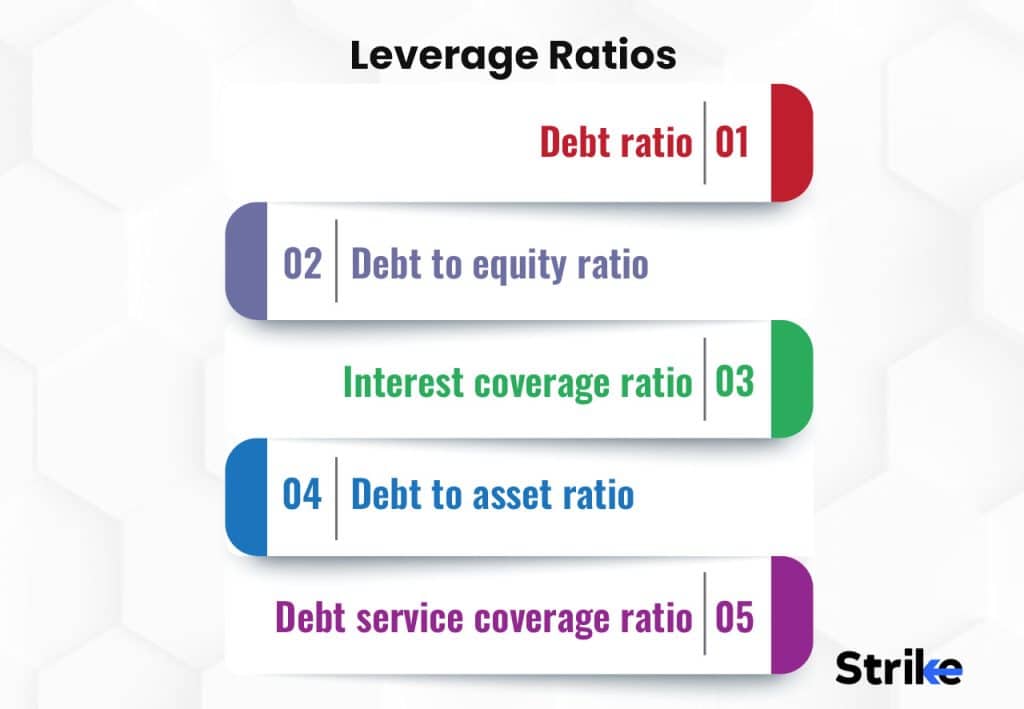
Financial leverage ratios offer insight into a company’s capital structure and ability to meet its financial obligations. A higher ratio indicates greater financial leverage and risk, while a lower ratio suggests less leverage and more financial stability. Evaluating leverage helps management assess the balance between debt financing and equity financing. Maintaining an optimal leverage structure promotes growth while avoiding excessive interest expenses that create financial distress. Tracking leverage over time provides a benchmark to inform financing decisions and evaluate financial health.
Debt ratio
The debt ratio measures a company’s total liabilities as a percentage of total assets. It indicates the proportion of assets financed through debt. The debt ratio helps assess a company’s leverage, financial risk, and ability to pay off debts. The debt ratio provides key insights into a company’s capital structure.
Debt Ratio = Total Liabilities / Total Assets.
A higher ratio means greater leverage and more risk, while a lower ratio indicates less leverage and more financial stability.
For example, suppose a company has Rs.2 million in total liabilities and Rs.5 million in total assets; the debt ratio = Rs.2,000,000 / Rs.5,000,000 = 0.4 or 40%
This means 40% of the company’s assets are financed through debt.
Debt to equity ratio
The debt-to-equity Ratio measures the relationship between a company’s total liabilities and shareholders’ equity. It indicates the degree to which a firm is financing its operations through debt versus wholly-owned funds. The Ratio is useful for analyzing the capital structure and assessing a firm’s ability to pay off long-term debts.
Debt to Equity Ratio = Total Liabilities / Shareholders’ Equity
A higher ratio indicates greater long-term solvency risk, while a lower ratio suggests less leverage and more financial stability.
For example, suppose a company has Rs.2 million in total liabilities and Rs.3 million in shareholders’ equity; its debt-to-equity Ratio = Rs.2,000,000 / Rs.3,000,000 = 0.67
This shows that for every Rs.1 of equity, the company has Rs.0.67 of debt.
Interest coverage ratio
The interest coverage ratio measures how easily a company pays interest expenses on outstanding debt. It is calculated by dividing a company’s earnings before interest and taxes (EBIT) by its interest expenses for the same period. Comparing the Ratio over time shows an improvement or worsening in debt service capacity.
Interest Coverage Ratio = EBIT / Interest Expenses
A higher ratio indicates a greater cushion for paying interest costs. A lower ratio suggests the company has trouble meeting interest obligations.
For example, suppose a company has Rs.500,000 in EBIT and Rs.100,000 in interest expenses; its interest coverage ratio = Rs.500,000 / Rs.100,000 = 5
This means the company has five times more EBIT than needed to cover its interest obligations.
Debt to asset ratio
The debt-to-asset Ratio measures the proportion of a company’s assets that are financed through debt. It calculates the Ratio of total debt to total assets. Comparing the Ratio over time or to industry benchmarks provides insights into a company’s changing capital structure and use of debt financing.
Debt to Asset Ratio = Total Debt / Total Assets
A higher ratio indicates greater financial leverage and risk, while a lower ratio suggests less leverage.
For example, suppose a company has Rs.500,000 in total debt and Rs.2,000,000 in total assets,
its debt to asset ratio = Rs.500,000 / Rs.2,000,000 = 0.25
This indicates that debt accounts for 25% of the company’s total assets.
Debt service coverage ratio
The debt service coverage ratio measures a company’s ability to repay debt obligations from operating income. It compares net operating income to total debt service payments. Tracking this Ratio over time provides insight into improving or worsening debt repayment capacity. Comparing industry benchmarks also provides a useful perspective.
Debt Service Coverage Ratio = Net Operating Income / Total Debt Service
A higher ratio indicates a greater ability to service debts from operations. A lower ratio suggests potential difficulty meeting obligations.
For example, suppose a company has Rs.1 million in net operating income and Rs.500,000 in total debt service payments,
its debt service coverage ratio = Rs.1,000,000 / Rs.500,000 = 2
This indicates the company has two times more operating income than needed to cover its debt payments.
3. Operating Ratios
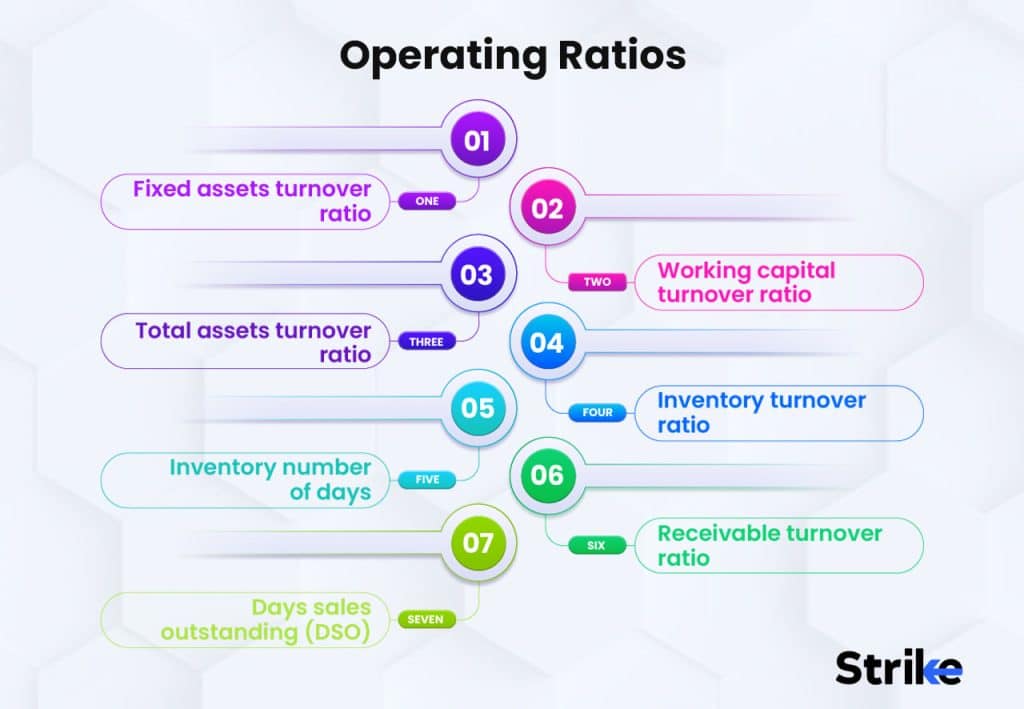
Operating ratios are key metrics used by investors to evaluate the efficiency and profitability of a company. By comparing revenue to expenses, operating ratios give insight into how well a company is controlling costs and generating profits from its operations. Wise investors dig into the operating ratios to understand the underlying health of the business when analyzing stocks. Favorable ratios indicate a company is operating efficiently and has the potential to deliver strong returns over time. Unfavorable trends in operating ratios signal problems and weaknesses in a company’s core operations. Tracking operating ratios helps investors spot the most promising stocks to buy and hold for long-term growth.
Fixed assets turnover ratio
The fixed assets turnover ratio measures how efficiently a company uses its fixed assets to generate revenue.
Fixed Assets Turnover Ratio = Net Sales / Average Fixed Assets
A higher ratio indicates assets are being used more efficiently to produce sales.
For example, ABC Company had Rs.5 million in net sales last year. Its average fixed assets for the year were Rs.2 million. So its fixed assets turnover ratio = Rs.5 million net sales / Rs.2 million average fixed assets = 2.5
This means for every Rs.1 in fixed assets, ABC Company generated Rs.2.5 in revenue. A higher ratio is preferred, as it indicates the company is utilizing assets optimally to drive sales. The Ratio helps assess operational efficiency and how asset-intensive a business is.
Working capital turnover ratio
The working capital turnover ratio measures the efficiency of a company’s use of working capital to generate sales revenue.
Working Capital Turnover Ratio = Net Sales / Average Working Capital
Where Working capital is current assets minus current liabilities.
A higher ratio indicates greater sales efficiency from working capital.
For example, ABC Company had Rs.10 million in net sales last year. Its average working capital for the year was Rs.2 million. So working capital turnover ratio =Rs.10 million net sales / Rs.2 million average working capital = 5
This means for every Rs.1 in working capital, ABC Company generated Rs.5 in revenue. A higher ratio shows the effective use of working capital to drive sales. The Ratio assesses a company’s liquidity and ability to turn assets into cash flows.
Total assets turnover ratio
The total assets turnover ratio measures the efficiency of a company’s use of its assets to generate sales revenue.
Total Assets Turnover Ratio = Net Sales / Average Total Assets
A higher ratio means assets are being better utilized to produce sales.
For example, XYZ Company had Rs.20 million in net sales last year. Its average total assets for the year were Rs.10 million. So its total assets turnover ratio = Rs.20 million net sales / Rs.10 million average total assets = 2.0
This means for every Rs.1 in assets, XYZ Company generated Rs.2 in revenue. A higher ratio indicates assets are being optimally employed to drive sales. The Ratio assesses how productive a company’s assets are and how capital-intensive its operations are. It helps investors determine management’s effectiveness in using assets to generate revenues.
Inventory turnover ratio
The inventory turnover ratio calculates how efficiently a company sells and replaces its inventory during a period.
Inventory Turnover Ratio = Cost of Goods Sold / Average Inventory
A higher turnover ratio indicates greater efficiency in selling inventory.
For example, ABC Company had Rs.5 million in cost of goods sold last year. Its average inventory for the year was Rs.1 million. So its inventory turnover ratio = Rs.5 million cost of goods sold / Rs.1 million average inventory = 5
This means ABC Company turned over its inventory five times during the year. A higher ratio shows inventory is sold quickly, there are fewer costs to store it, and working capital is freed up. The Ratio helps assess inventory management, production efficiency, and product demand. It shows how many times inventory cycles through a company annually.
Inventory number of days
The inventory number of days ratio calculates the average number of days a company holds its inventory before selling it.
Inventory Number of Days = 365 / Inventory Turnover Ratio
A lower number indicates greater inventory efficiency.
For example, XYZ Company has an inventory turnover ratio of 5 times per year. Its inventory number of days = 365 / 5 inventory turnovers = 73 days
This means XYZ Company sells its entire inventory in 73 days on average. A lower number of inventory days is more efficient, as it indicates inventory moves quickly from purchase to sale. This frees up working capital otherwise tied up in inventory. The Ratio helps identify if a company has excessive inventory levels and assess the overall liquidity of inventory assets. Companies aim to optimize their inventory number of days.
Receivable turnover ratio
The receivables turnover ratio measures how efficiently a company collects payment owed from its credit sales to customers.
Receivables Turnover Ratio = Net Credit Sales / Average Accounts Receivable
A higher ratio indicates greater efficiency in collecting receivables.
For example, ABC Company had Rs.20 million in net credit sales last year. Its average accounts receivable was Rs.5 million. So its receivables turnover ratio = Rs.20 million net credit sales / Rs.5 million average accounts receivable = 4
This means ABC Company turned over its receivables four times during the year. A higher ratio shows accounts receivable are being collected quickly, reducing risks of late or uncollected payments. The Ratio helps assess the efficiency of credit and collection policies. It shows how many times it receives “turnover” per year.
Days sales outstanding (DSO)
Days sales outstanding (DSO) measures the average number of days it takes a company to collect payment on its credit sales.
DSO = Accounts Receivable / (Net Credit Sales / 365)
A lower DSO indicates greater efficiency in collecting accounts receivable.
For example, XYZ Company had Rs.1 million in accounts receivable and Rs.5 million in net credit sales last year. Its DSO = Rs.1 million accounts receivable / (Rs.5 million net credit sales / 365 days) = 73 days
This means XYZ Company takes roughly 73 days on average to collect payment on credit sales. A lower DSO shows accounts receivable are being collected quickly, reducing the risks of late payments. The Ratio helps assess the efficiency of credit and collection policies. Companies aim to optimize DSO to ensure the timely collection of receivables.
4. Valuation Ratios
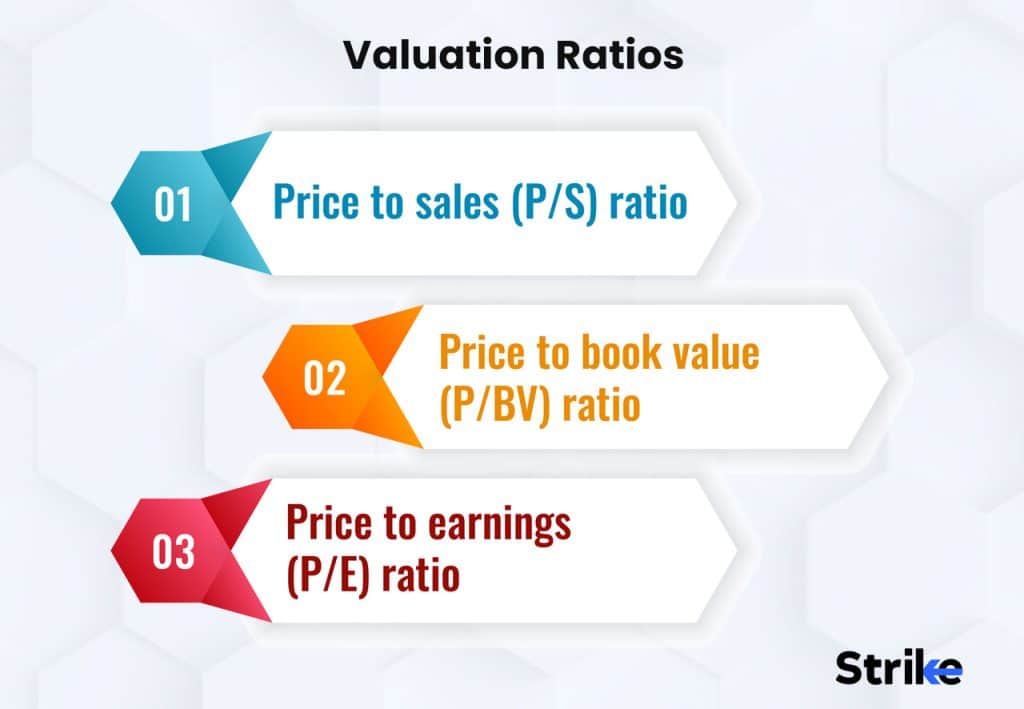
Valuation ratios are important metrics used by investors to assess the value of a company’s stock price relative to metrics like earnings, cash flow, book value, and sales. Common valuation ratios include the price-to-earnings ratio, price-to-book ratio, and price-to-sales ratio. These ratios allow investors to compare the current stock price against fundamentals to determine if a stock is undervalued or overvalued. Many factors beyond just ratios influence stock prices. Investors should use valuation ratios together with other techniques like discounted cash flow analysis to thoroughly evaluate a stock’s fair value before making an investment decision.
Price to sales (P/S) ratio
The price-to-sales Ratio (P/S ratio) is a valuation metric used to compare a company’s stock price to its revenues. It is calculated by dividing a company’s market capitalization by its total sales or revenue over the last 12 months.
P/S Ratio = Market Capitalization / Total Sales or Revenues
A higher P/S ratio generally indicates that the market has greater confidence that a company’s stock is worth more per dollar of sales.
For example, suppose Company A has a market capitalization of Rs.2 billion and total sales last year of Rs.1 billion; its P/S ratio would be 2 (Rs.2 billion / Rs.1 billion). This means investors value Company A’s stock at Rs.2 for every Rs.1 of sales revenue generated.
Price to book value (P/BV) ratio
The price-to-book value (P/BV) ratio compares a company’s market value to its book value. Book value represents the company’s assets minus liabilities. The P/BV ratio gives investors an indication of whether a stock is undervalued or overvalued.
P/BV Ratio = Market Capitalization / Book Value
A lower P/BV indicates a stock is undervalued, while a higher ratio suggests it is potentially overvalued.
For example, suppose Company X has a market capitalization of Rs.5 billion and its book value is Rs.2 billion, its P/BV ratio is 2.5 (Rs.5 billion / Rs.2 billion). This suggests investors value Company X at 2.5 times its book value, which means the stock is trading at a premium.
Price to earnings (P/E) ratio
The price-to-earnings (P/E) ratio is a valuation measure used to compare a company’s current share price to its per-share earnings. It shows how much investors are willing to pay for each dollar of the company’s earnings.
P/E Ratio = Market Price per Share / Earnings per Share
A higher P/E ratio indicates investors expect higher future growth and are willing to pay more for the stock. A low P/E ratio could mean the stock is undervalued.
For example, suppose Company A has a current market price of Rs.50 per Share and earnings over the last 12 months of Rs.5 per Share; its P/E ratio is 10 (Rs.50 per share / Rs.5 per share earnings). This suggests investors are paying Rs.10 for every Rs.1 of earnings for Company A’s stock, which is often seen as a moderate P/E.
5. Liquidity Ratios
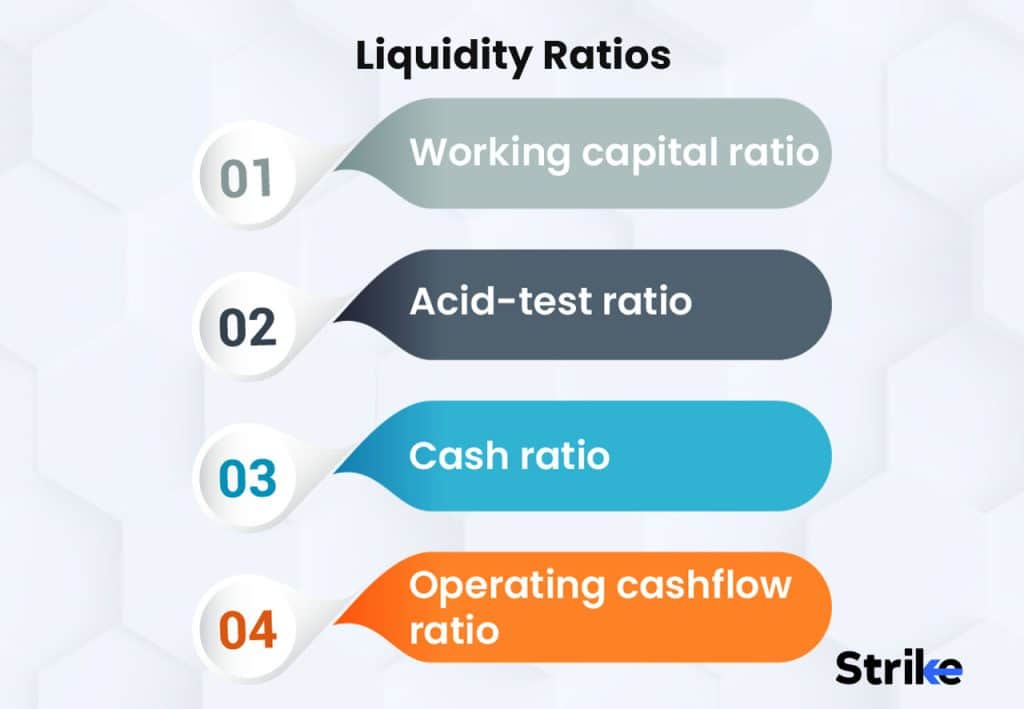
Liquidity ratios are an important indicator of a company’s financial health and viability as an investment. The current Ratio and quick Ratio specifically measure a company’s ability to meet its short-term obligations with its current assets. Investors should look for companies with strong liquidity ratios, as this suggests the company easily converts assets to cash to pay off debts and continue operations. Companies with weak liquidity struggle to meet obligations during downturns without taking on more debt or diluting shares. Liquidity ratios help investors assess the company’s cash management and get a sense of its financial flexibility and stability when analyzing stocks. Favorable liquidity ratios signal a company is better positioned to provide consistent returns even in challenging markets.
Working capital ratio
The working capital ratio measures a company’s short-term liquidity and ability to meet its upcoming financial obligations. It compares a company’s current assets to its current liabilities.
Working Capital Ratio = Current Assets / Current Liabilities.
A higher ratio indicates greater liquidity and financial health.
For example, suppose a company has Rs.2 million in current assets and Rs.1 million in current liabilities; its working capital ratio would be 2 (Rs.2 million / Rs.1 million). This indicates it has twice as many current assets than liabilities to cover its short-term debts.
Acid-test Ratio
The acid-test Ratio, also called the Quick Ratio, measures a company’s ability to use its most liquid assets to pay off its current liabilities. It is a more conservative measure of liquidity than the current Ratio.
Acid-Test Ratio = (Cash + Cash Equivalents + Short-Term Investments + Accounts Receivable) / Current Liabilities.
A ratio of 1 or higher indicates good short-term financial strength.
For example, suppose a company has Rs.100,000 in cash, Rs.50,000 in accounts receivable, and Rs.150,000 in current liabilities; its acid-test Ratio would be 1 (Rs.150,000 in liquid assets / Rs.150,000 in current liabilities). This suggests it pays off its short-term debts using its quick assets.
Cash ratio
The cash ratio measures a company’s capacity to pay off its short-term debt obligations with only cash and cash equivalents. It provides the most conservative measure of a company’s liquidity position.
Cash Ratio = (Cash + Cash Equivalents) / Current Liabilities.
A higher ratio indicates a stronger ability to cover short-term obligations.
For example, suppose a company has Rs.20,000 in cash, Rs.10,000 in marketable securities, and Rs.30,000 in current liabilities; its cash ratio is 1 (Rs.30,000 in cash and cash equivalents / Rs.30,000 in current liabilities). This suggests the company pays off its short-term debts using only its most liquid assets.
Operating cash flow ratio
The operating cash flow ratio measures how well a company pays off its current liabilities with the cash generated from its core business operations. It evaluates operating liquidity.
Operating Cash Flow Ratio = Operating Cash Flow / Current Liabilities.
A higher ratio indicates a company covers its short-term debts with operating cash flow.
For example, suppose a company has Rs.100,000 in operating cash flow and Rs.150,000 in current liabilities; its operating cash flow ratio is 0.67 (Rs.100,000 / Rs.150,000). This suggests that the company’s operating cash flow is not sufficient to cover its short-term debts, and it needs to find other sources of cash.
6. Market Ratios
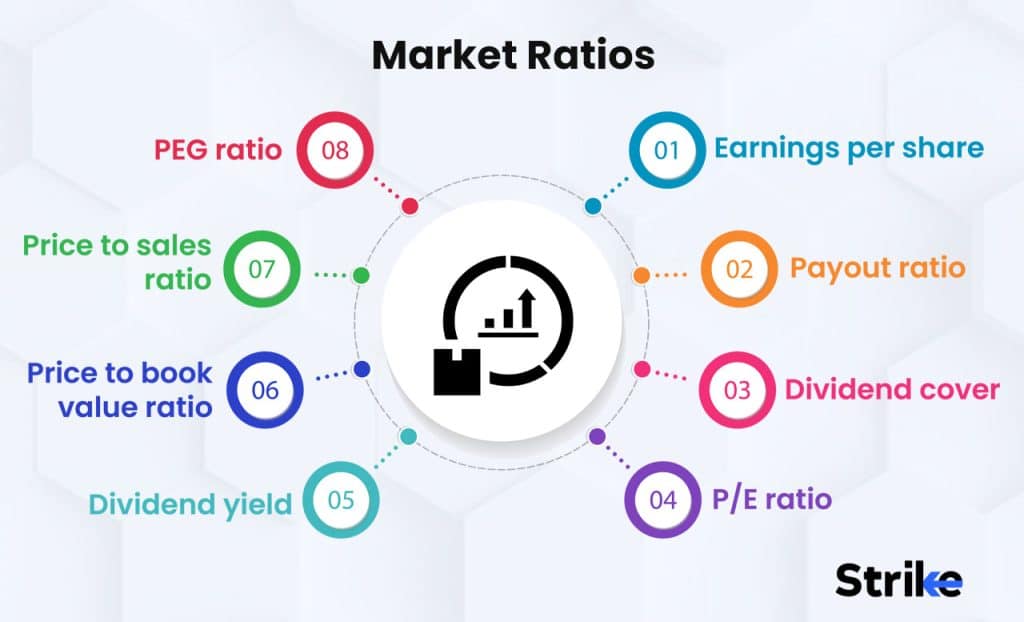
Market ratios are metrics used by investors to evaluate and compare stocks within an industry or sector. These ratios allow investors to identify under or overvalued stocks and assess financial health. By benchmarking companies using market ratios, investors are able to spot valuation anomalies and find stocks that rip for investment based on the fundamentals.
Earnings per Share
Earnings per Share (EPS) measures a company’s net income allocated to each Share of common stock outstanding. It represents profitability attributable to shareholders on a per-share basis.
Earnings Per Share = (Net Income – Preferred Dividends) / Average Outstanding Shares.
A higher EPS indicates greater profitability per Share held.
For example, suppose a company has Rs.20 million in net income, Rs.1 million in preferred dividends, and 10 million shares outstanding; its EPS is Rs.1.90 (Rs.20 million – Rs.1 million / 10 million shares). This EPS level provides insight into the profit generated for each Share of stock.
Payout ratio
The payout ratio measures the percentage of earnings paid out to shareholders in dividends. It shows how much of a company’s profit is returned to investors rather than reinvested back into the business.
Payout Ratio = Common Share Dividends / Net Income.
A high payout ratio cannot be sustainable in the long term if too much profit is paid out.
For example, suppose a company pays Rs.2 million in dividends from a net income of Rs.10 million; its payout ratio is 20% (Rs.2 million / Rs.10 million). This indicates that 20% of the company’s profits are returned to shareholders as dividends. The remaining 80% is retained for reinvestment and growth.
Dividend cover
Dividend cover, also called dividend coverage ratio, measures how many times a company could pay its dividend from its net income over a period. It evaluates the sustainability of dividend payments.
Dividend Cover = Earnings per Share / Dividend per Share.
A higher coverage ratio indicates dividends are more affordable for the company.
For example, suppose a company has earnings per share of Rs.2 and a dividend per share of Rs.1; its dividend cover is 2 (Rs.2 / Rs.1). This suggests the company could afford to pay its dividend twice over from earnings. A high coverage ratio provides reassurance on continued dividend payments.
P/E ratio
The price-to-earnings ratio (P/E ratio) measures a company’s current share price relative to its earnings per Share (EPS). It provides a valuation of a stock’s price compared to its underlying profitability.
P/E Ratio = Market Price per Share / Earnings per Share.
A high P/E suggests potential overvaluation, while a low P/E indicates an undervalued stock.
For example, suppose a stock is trading at Rs.50 per Share, and its EPS is Rs.5, the P/E ratio is 10 (Rs.50 per share / Rs.5 EPS). This implies investors are willing to pay Rs.10 for every Rs.1 of earnings. The P/E gauges investor expectations of future growth prospects.
Dividend yield
Dividend yield calculates the dividend per Share as a percentage of the share price. It helps investors evaluate if the dividend is worth the stock’s valuation and current price.
Dividend Yield = Annual Dividends per Share / Price per Share.
A higher dividend yield is more appealing to income-seeking investors.
For example, suppose a stock pays Rs.1 in annual dividends per Share and trades at Rs.25 per Share; its dividend yield is 4% (Rs.1 / Rs.25). This suggests for every Rs.25 invested in the stock, it would generate Rs.1 in dividend income annually. The dividend yield helps assess the income-generating potential of a stock investment.
Price-to-book value ratio
The price-to-book Ratio (P/B ratio) compares a company’s market valuation to its book value or net assets. It provides a way to gauge whether a stock is undervalued or overvalued relative to its accounting value.
Price to Book Ratio = Market Price per Share / Book Value per Share.
A lower P/B indicates an undervalued stock with growth potential.
For example, suppose a stock is trading at Rs.20 per Share and has a book value of Rs.10 per Share; its P/B ratio is 2 (Rs.20 per share / Rs.10 book value per Share). A P/B below 1 suggests the stock is undervalued relative to its asset value on the balance sheet.
Price-to-sales ratio
The price-to-sales Ratio (P/S ratio) compares a company’s market capitalization to its total sales or revenue. It helps gauge whether a stock is overvalued or undervalued relative to its top-line revenue.
Price to Sales Ratio = Market Capitalization / Total Revenue.
A lower P/S ratio indicates an undervalued stock.
For example, suppose a company has a market cap of Rs.2 billion and a total annual revenue of Rs.500 million; its P/S ratio is 4 (Rs.2 billion market cap / Rs.500 million revenue). The P/S ratio helps identify stocks trading at a discount to their overall sales.
PEG ratio
The PEG ratio (price/earnings-to-growth ratio) compares a company’s price-to-earnings (P/E) Ratio to its expected earnings growth rate. It provides a more complete valuation measure than just the P/E ratio.
PEG Ratio = P/E Ratio / Projected Annual Earnings Growth Rate.
A lower PEG indicates an undervalued stock, given its projected growth.
For example, suppose a stock has a P/E of 20 and expected earnings growth of 10%, its PEG is 2 (20 P/E / 10% growth = 2 PEG). A PEG of 1 or less suggests potential undervaluation for a stock’s growth outlook. The PEG helps identify reasonably priced, high-growth stocks.
7. Efficiency Ratios
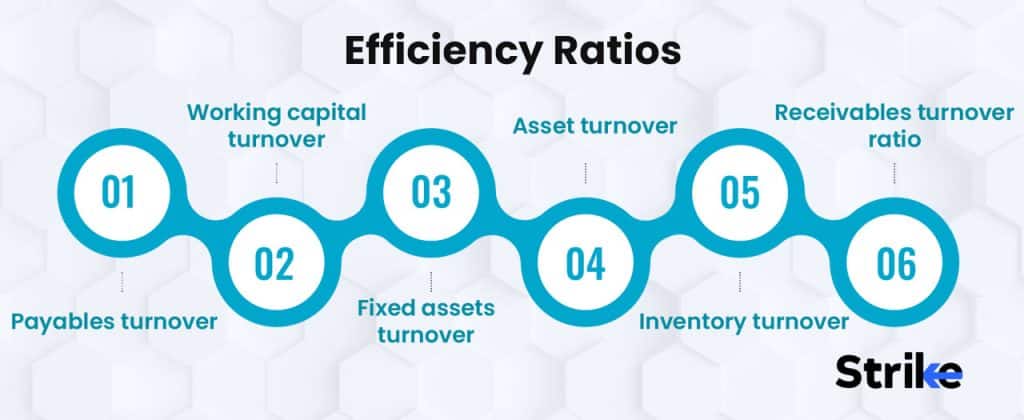
Efficiency ratios are important metrics used by investors and analysts to evaluate how effectively a company is utilizing its assets and managing expenses. Efficiency ratios also reveal issues like bloated inventories or poor collection processes. They provide insights into which companies are operating leanly and converting assets into profits most effectively when comparing stocks. Assessing efficiency helps investors identify well-run companies that make effective use of capital. Tracking efficiency ratios over time also shows if a company’s performance is improving or deteriorating. Analysis of efficiency ratios is a critical component of due diligence when evaluating stocks.
Payables turnover
Payables turnover is a ratio used to measure how efficiently a company manages its accounts payable. It indicates how many times a company pays off its accounts payable during a period.
Payables Turnover = Net Credit Purchases / Average Accounts Payable.
Net credit purchases are purchases made on credit during a period. Average accounts payable is the average amount owed to suppliers during the same period.
For example, suppose a company has Rs.1 million in net credit purchases during a year and an average accounts payable balance of Rs.200,000; its payables turnover is 5. This means it paid off its average payables balance five times during the year, indicating reasonably efficient management of accounts payable.
Working capital turnover
Working capital turnover measures how efficiently a company uses its working capital to generate sales. It indicates how many times working capital is turned over during a period.
Working Capital Turnover = Net Sales / Average Working Capital.
Net sales are total sales minus returns, allowances, and discounts. Average working capital is the average amount invested in current assets minus current liabilities.
For example, suppose a company has Rs.5 million in net sales during a year and an average working capital of Rs.1 million; its working capital turnover is 5. This means the company generated Rs.5 in sales for every Rs.1 invested in working capital, indicating efficient use of working capital. A higher ratio generally indicates better-working capital management.
Fixed assets turnover
Fixed assets turnover measures the efficiency of a company’s use of fixed assets to generate sales revenue. It indicates how well a company is utilizing investments in plant, property, and equipment.
Fixed Assets Turnover = Net Sales / Average Fixed Assets.
Net sales are total sales revenue minus returns, allowances, and discounts. Average fixed assets is the average net book value of property, plant, and equipment during the period.
For example, suppose a company has Rs.10 million in net sales and average fixed assets of Rs.2 million; its fixed asset turnover ratio is 5. This means the company generated Rs.5 in sales for every Rs.1 invested in fixed assets. A higher ratio indicates assets are being used efficiently to generate sales. A low ratio indicates excess fixed assets or inefficient use of long-term assets.
Asset turnover
Asset turnover measures the efficiency of a company’s use of its total assets to generate sales revenue. It indicates how well a company is utilizing its total asset investment to produce sales.
Asset Turnover = Net Sales / Average Total Assets.
Net sales are total sales revenue minus returns, allowances, and discounts. Average total assets are the average value of all assets on the company’s balance sheet during the period.
For example, suppose a company has Rs.20 million in net sales and average total assets of Rs.10 million; its asset turnover ratio is 2. This means the company generated Rs.2 in sales for every Rs.1 invested in assets. A higher ratio indicates assets are being used productively to generate sales. A lower ratio indicates inefficient use of assets or over-investment in assets.
Inventory turnover
Inventory turnover measures how efficiently a company manages its inventory and how quickly it converts inventory into sales. It indicates how many times the average inventory is turned over or sold during a period.
Inventory Turnover = Cost of Goods Sold / Average Inventory.
The cost of goods sold is the cost of products sold during the period. Average inventory is the average value of inventory on hand during the period.
For example, suppose a company has Rs.5 million in cost of goods sold during a year and an average inventory of Rs.1 million; its inventory turnover is 5. This means the company turned over its average inventory five times, indicating efficient inventory management. A high turnover signals effective inventory and production management.
Receivables turnover ratio
The receivables turnover ratio measures how efficiently a company collects payment for credit sales during a period. It indicates the number of times average receivables are turned into cash.
Receivables Turnover = Net Credit Sales / Average Accounts Receivable.
Net credit sales are total credit sales minus returns. Average accounts receivable is the average amount owed by customers during the period.
For example, suppose a company has Rs.2 million in net credit sales during a year and an average accounts receivable balance of Rs.500,000; its receivables turnover is 4. This means the company turned over its average receivables four times, implying reasonably effective credit and collection policies. A higher ratio indicates a more efficient collection of account balances.
8. Solvency Ratios
Solvency ratios measure a company’s ability to meet its long-term financial obligations. They indicate the adequacy of a company’s cash flow to pay its debts and other obligations.
Key solvency ratios include the debt-to-equity ratio, interest coverage ratio, and debt service coverage ratio. The debt-to-equity ratio compares total liabilities to shareholder equity. The interest coverage ratio compares earnings to interest expenses. The debt service coverage ratio compares earnings to total debt payment obligations.
For example, suppose a company has Rs.2 million in total liabilities, Rs.5 million in shareholder equity, Rs.1 million in net income, Rs.200,000 in interest expenses, and Rs.500,000 in debt payments; its debt-to-equity Ratio would be 0.4, interest coverage ratio would be 5, and debt service coverage ratio would be 2. These ratios indicate the company is likely able to meet its long-term obligations.
9. Capital budgeting Ratios
Capital budgeting ratios evaluate the profitability and return on proposed capital investments and projects. They help companies determine if an investment is worth pursuing.
Key ratios include the payback period, accounting rate of return (ARR), net present value (NPV), and internal rate of return (IRR). The payback period measures how long it takes to recover an investment. ARR measures are expected to return as a percentage. NPV estimates today’s value of future cash flows. IRR calculates the return rate based on discounted cash flows.
For example, suppose a Rs.100,000 investment is expected to produce Rs.20,000 in annual savings; the simple payback period would be five years. The ARR is 20% (Rs.20,000/Rs.100,000). The NPV and IRR would depend on the estimated useful life, discount rate, and projected cash flows. These ratios inform capital budgeting decisions.
What is the source of finding financial ratios?
One of the most commonly used sources is the financial statements of the companies, which are available either on the company’s official website or on regulatory bodies’ websites. Companies listed on Indian stock exchanges like BSE and NSE are required to regularly file their audited financial statements with these exchanges. Investors and analysts can access years of income statements, balance sheets, and cash flow statements to calculate key ratios.
Regulatory bodies like the Ministry of Corporate Affairs also have an online database called MCA21, where financial statements of many Indian companies can be accessed. In addition, websites of rating agencies like CRISIL, ICRA, and CARE provide pre-calculated financial ratios for rated companies. Business newspapers like The Economic Times and websites of research firms like Capitaline, MoneyControl, and Business Standard also regularly feature important financial metrics and ratios of listed Indian corporations analyzed by their experts. International databases like Bloomberg also cover major Indian companies and offer detailed financial analysis.
What is the framework for ratio analysis?
The key frameworks for ratio analysis include horizontal analysis of trends over time, vertical analysis of line items as a percentage of revenue, trendline analysis to identify patterns, industry analysis benchmarking against competitors, liquidity ratios for short-term health, leverage ratios for debt levels, profitability ratios for bottom line strength, and efficiency ratios to measure asset utilization. Ratio analysis provides insights into strengths, weaknesses, and progress.
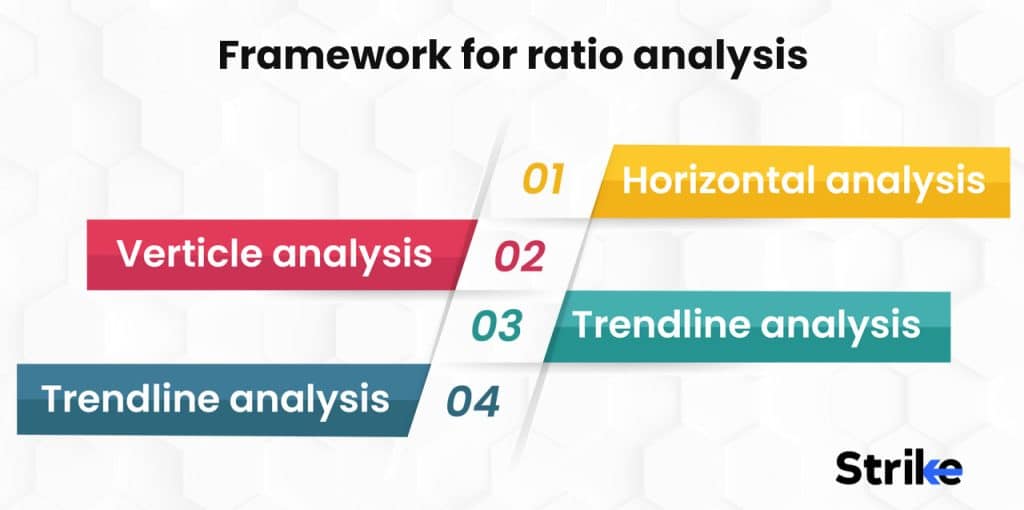
Horizontal analysis
Horizontal analysis is a critical framework for evaluating the financial performance of a company over time when performing stock market analysis. This technique involves comparing numbers on the financial statements between two or more years to identify increases and decreases in accounts as well as growth trends.
For example, an investor uses horizontal analysis on the income statement to calculate the year-over-year change in revenue, cost of goods sold, operating expenses, net income, and other accounts. This provides insight into the company’s sales growth, profitability improvements, and other trends. Comparing balance sheet numbers horizontally shows changes in asset accounts, liabilities, and equity over time.
Horizontal analysis helps investors assess the improving or deteriorating financial strength of a company. Steady growth in revenue and profits indicates a company with competitive advantages and effective strategies. Declining margins or unstable sales could signal problems ahead. Comparing growth rates to industry benchmarks also provides context on performance.
Horizontal analysis provides a critical historical perspective when deciding whether to invest in a stock. Reviewing financial ratios like return on assets and profit margins over the past 5-10 years reveals positive or negative trajectories.
Vertical analysis
Vertical analysis is another important ratio analysis technique for evaluating a company’s financial statements when performing stock analysis. This involves analyzing items on the financial statements as a percentage of a key benchmark, such as total revenue or total assets.
For example, on the income statement, each line item is expressed as a percentage of total revenue. This allows an investor to evaluate trends in the cost structure and profitability relative to revenue. It indicates the company is becoming more profitable, if the gross margin or net profit margin as a percent of revenue is increasing over time.
On the balance sheet, the vertical analysis might involve analyzing each asset and liability as a percentage of total assets. This reveals insights like what portion of assets are tied up in inventory versus current assets or how reliance on debt financing changes over time.
Vertical analysis allows investors to evaluate financial statement items independent of absolute dollar amounts, which vary widely for companies of different sizes. By standardizing to a base amount like revenue, the analysis focuses on relative proportions and trends. This reveals how well a company is managing its profitability, costs, asset efficiency, and leverage.
Trendline analysis
Trendline analysis is a technique used by investors to visually identify overall patterns and trajectories of financial metrics over time. It involves plotting important ratios or financial statement amounts on a graph and connecting the data points with a linear trendline.
Some key uses of trendlines in stock analysis include plotting the company’s revenue, net income, EPS, and stock price over the past 5-10 years. Connecting these points with trendlines makes it easy to spot positive, negative, or fluctuating trends. A positive sloping trendline indicates steady growth, while a negative slope implies a decline. Investors want to see positive trendlines for key financial drivers.
Trendlines also visualize performance on important financial ratios like return on equity, profit margins, P/E ratios, current ratios, and many others. Reviewing these trendlines allows investors to identify areas of improving or worsening financial performance. Comparisons are also made to trendlines of industry averages.
Adding trendline analysis enhances the insights from ratio analysis and historical financial review. Investors are better equipped to predict future performance based on clearly visualized financial trends. While past performance does not guarantee future results, trendline analysis provides the critical context and perspective needed for informed investment decision-making in the stock market. Identifying concerning trends early allows investors to avoid risky or underperforming stocks.
Industry analysis
Performing industry analysis is a critical component of due diligence for stock market investors. This involves comparing a company’s financial ratios and performance metrics to industry benchmarks and competitors.
For any major industry, investors find industry average ratios for profitability, liquidity, leverage, efficiency, and growth. Comparing a company’s current ratios and trends to the industry averages provides an important perspective on their relative performance. It could signal competitive strengths or weaknesses if key ratios are far above or below industry norms.
Investors will also want to identify the company’s main competitors within the industry. The financial statements and ratios of the competitors are compared side-by-side to evaluate relative strengths. For example, comparing profit margins, return on equity, and revenue growth reveals which companies are most efficiently converting business activities into profits.
Industry analysis enables investors to determine if a company’s performance and outlook are aligned with broader industry trends. For example, an industry facing disruption or consolidation requires a different strategy than a steadily growing industry.
Incorporating industry analysis through benchmarking and peer comparisons, a key component of fundamental analysis, allows investors to better evaluate companies within the appropriate context. The insights gathered from industry analysis, enriched by fundamental analysis, are essential for stock investors to identify companies with promising performance and competitive positioning within their respective sectors. Fundamental analysis plays a vital role in this process, ensuring that investment decisions are backed by robust research. This approach, emphasizing the importance of fundamental analysis, helps investors discern the true potential and risks associated with different investment opportunities.
What are the uses of financial ratio analysis?
The key uses of financial ratio analysis are to evaluate a company’s financial health, performance, valuation, credit risk, and operational efficiency by analyzing trends, making comparisons, and gaining insights from the quantitative metrics calculated from financial statement data.
Ratio analysis allows analysts and investors to evaluate a company’s financial health. Key ratios like the current ratio and debt-to-equity ratio provide insight into a company’s liquidity, leverage, and ability to meet its short-term and long-term obligations. Unusual changes in these ratios over time signal financial distress or improvement.
Financial ratios help measure a company’s performance in terms of profitability, efficiency, and returns for shareholders. Ratios like return on assets, return on equity, profit margin, and asset turnover gauge how well a company is generating profits and revenue relative to the assets and equity invested in the business. Comparing these ratios to past performance, competitor averages, or industry benchmarks allows for the assessment of management effectiveness.
Analyzing past and current ratios provides a basis for making educated guesses about a company’s future prospects. For example, an increasing accounts receivable turnover ratio suggests a company expects rising sales and cash flow going forward. Ratio analysis enhances predictive ability and supplements other forecasting methods.
Certain financial ratios are used in valuation models to determine the intrinsic value of a company. The price-to-earnings Ratio is a well-known valuation ratio. However, ratios based on cash flow or book value are also useful valuation tools in some cases. Financial ratios help investors determine if a stock is undervalued or overvalued.
Ratio analysis helps investors screen for potential stock investments. Stocks are screened based on preferred criteria, such as a minimum current ratio, maximum debt-to-equity ratio, or minimum return on equity. Stocks passing the screening criteria warrant further research and analysis.
Ratios relating expenses to sales or assets could quantify how efficiently a company is operating. The operating expense ratio shows how much it costs to generate each dollar of sales revenue. Trend analysis and comparison to industry benchmarks reveal improvements or deteriorations in operating efficiency over time.
In addition to measuring company performance, financial ratios reflect the abilities and decisions of management. Improving profitability, liquidity, and leverage ratios indicate effective financial management. Worsening ratios indicate poor operational or strategic decisions from top executives.
An unusual fluctuation in a financial ratio raises a red flag that something is amiss. For example, a disproportionate increase in the inventory turnover ratio could signal impending inventory write-downs or obsolescence. Shifts in other ratios indicate problems collecting receivables, increased risk of default, or other issues.
A company’s financial ratios are compared directly to those of major competitors. This side-by-side comparison reveals how the company is positioned in areas like profitability, leverage, liquidity, and asset efficiency. Comparing to competitors helps contextualize a company’s own ratio results.
Ratio analysis enables comparison against industry-wide benchmarks. A company evaluates if its financial ratios align with the average ratios for the industry sector in which it operates. This reveals if the company’s performance is on par, below average, or above average compared to sector peers.
Who uses financial ratio analysis?
Financial ratio analysis are used by a variety of stakeholders, including company management, investors, creditors, and financial analysts, to evaluate a company’s financial statements and assess its financial health, performance, valuation, and credit risk. Company management will often calculate and analyze key financial ratios as part of their financial reporting and planning processes. Ratios help management identify strengths and weaknesses, benchmark performance against competitors, identify areas for improvement, and track progress over time. For example, management monitors liquidity ratios like the current Ratio to ensure the company has sufficient resources to meet short-term obligations. Profitability ratios like return on assets help assess how efficiently the company is generating profits from its assets. Management will compare current ratios to past periods, competitor benchmarks, and industry standards to gauge the company’s financial standing and adaptation abilities.
Financial analysts, such as research analysts and credit rating agencies, extensively use financial ratio analysis in their reports and models. Analysts apply ratio analysis to make quantitative comparisons of financial performance between companies and across industries. Comparing profitability and efficiency ratios helps analysts identify well-managed companies. Leverage and liquidity ratios assess credit risks and default probabilities. Market value ratios inform valuation and investment recommendations. Analysts will also make historical comparisons and project future ratio trajectories. Ratio analysis equips analysts with metrics to support their qualitative assessments and forecasts.
What are the limitations of financial ratio analysis?
The main limitations of financial ratio analysis are that ratios provide limited insights on their own, are manipulated through accounting policies, do not capture intangible assets, and should be compared to historical trends, competitor ratios, and industry benchmarks to give useful context.
The methods for accounting for inventory, depreciation, research & development, and other items differ between companies. These accounting discrepancies make it difficult to compare financial ratios directly. Normalizing the ratios to account for different accounting treatments helps compensate.
Financial statements reflect a company’s past performance. The use of historical data makes ratio analysis a backward-looking tool. Current ratios do not accurately represent a company’s future outlook or intrinsic value. Using projected data in addition to historical ratios helps to offset this limitation.
Quantitative ratios ignore valuable qualitative factors like management quality, employee morale, brand reputation, etc. The two companies have similar financial ratios but widely divergent qualitative positions. Financial ratios should be considered alongside other operational metrics and qualitative assessments.
Companies take steps to artificially improve certain financial ratios, especially near period-end. For example, paying suppliers just after the period ends reduces accounts payable and increases the current Ratio. Detecting and undoing distortion improves ratio analysis quality.
There are no universal standards for “good” or “bad” ratio values. Acceptable ranges vary significantly by industry. Even within an industry, differences in business models and strategies alter normative ratio levels. Intelligent financial analysis requires appropriate peer group benchmarking.
Financial ratios measure the end result. However, they do not reveal the underlying causes or variables driving the outcome. Additional investigation is required to diagnose factors influencing observed ratio levels and trends.
Financial statements provide a snapshot at a point in time. However, a company’s financial condition is dynamic. So ratios quickly become outdated, limiting their usefulness, especially in rapidly evolving industries. A more frequent ratio assessment is required to monitor the latest developments.
Larger companies tend to have significantly different capital structures and operations compared to smaller businesses. This reduces the comparability of financial ratios and could lead to improper conclusions. Where relevant, the analysis should be segmented by company size.
Companies with large investments in fixed assets and inventory tend to have very different financial ratios versus service businesses or software companies. Capital intensity should be considered when benchmarking ratio analysis to peers.
Increasingly complex accounting standards like leases, stock compensation, derivatives, etc., make it difficult to consistently define and calculate some financial ratios between companies and across time periods. Excluding impacted items helps boost comparability.
A company’s credit rating materially impacts its cost of debt and capital structure. Comparisons should be made against companies with similar credit risk. Comparing ratios without considering credit quality differences produces misleading results.








![85 Common Stock Market Terminologies for Dummies [Updated List for 2025] 112 85 Common Stock Market Terminologies for Dummies [Updated List for 2025]](https://www.strike.money/wp-content/uploads/2025/04/Popular-Stock-Market-Terms-for-Beginners-Banner.png)










No Comments Yet.